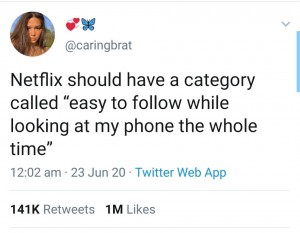By Katie Ellis with research by Gwyneth Peaty
In a tweet that has been liked by 1 million people and shared 141,000 times @caringbrat suggests Netflix introduce a category called “easy to follow while looking at my phone the whole time.”
While @caringbrat’s predicament has captured the attention of an increasingly distracted television audience, the category @caringbrat asks for already exists. It’s called audio description (AD) and it’s an accessibility feature for audiences who are blind or vision impaired. You can find it in the language options on Netflix.
For an example of AD see:
Audio description describes any visual element crucial to the story such as facial expressions, actions, costumes, even the weather. While Netflix was the first platform to offer an ongoing audio description service in Australia, Stan has it too, as does Apple TV+, Disney+ and Amazon Prime. Free-to-air television is late to the party.
However, after 30 years of advocacy, the feature is finally being introduced to Australian free to air television on 28 June 2020 on the public broadcasting networks the ABC and SBS. Emma Bennison, CEO of Blind Citizens Australia (BCA) celebrates the milestone as “live changing,” explaining that:
“BCA and other blindness organisations have worked closely with both the ABC and SBS to facilitate the rollout of AD. We acknowledge and thank them for their strong commitment to providing a quality service that will meet the needs of Australians who are blind or vision impaired. Our community looks forward to confirmation that AD will be a permanent fixture on Australian television beyond this current twelve-month funding period.”
The Centre of Culture and Technology (CCAT) is one of the organisations Ms Bennison refers to. Audio description has been a long-time research interest for CCAT. We have focused research on both the blind community and other groups who might benefit.
Inspired by Netflix’s Sense8 audience who discovered AD provided a useful layer of information to explain the difficult-to-follow narrative, in 2018 we introduced television fans to audio description. Just to see what they made of it.
We discovered two striking things.
First that 100% of the people we introduced the feature to believed that the feature should be made available to Australian television audiences who were blind or vision impaired straight away. This group truly believed access to television was a human right.
The second thing we discovered was that for our sighted participants, audio description added flexibility for those wanting to access television on the move or while multitasking:
“If I had the option to use audio description, I might well find myself listening more while cooking (because at the moment I try to watch some things while I’m chopping/stirring, and end up missing out on the action).”
While users of AD have long noted the potential of audio-described television for switching focus between watching television and other tasks, those bingeing on popular Netflix series appreciate the possibility to make television a more mobile, less visual medium.
As Emily Price explained on Lifehacker:
“I’ve tried it out with a few shows and the descriptions are actually pretty great. Stranger Things may have just become the soundtrack to my morning dog walks.”
During COVID-19 stay-at-home restrictions, subscriptions to video-on-demand platforms such as Netflix increased dramatically as people looked for ways to entertain themselves at home.
During quarantine, audiences began engaging in an activity they coined “audiobooking” or using the audio description narration to continue bingeing Netflix shows while doing other things.
“Sometimes, it is just not possible to keep your eyes on the screen – you might have some chores, you might actually be working on something and so on. Well, one option is to just keep your favorite show or film running and peek into it from time to time. Another is to keep pausing and playing them. Neither of which is really convenient.”
Instead, audiobooking allowed people to multitask and binge-watch at the same time.
In celebration of these innovative approaches to watching television with your ears, we call on the commercial stations to reveal their plans for this exciting moment in mobile, flexible television viewing.
________________________________________________________________________________________________________________________________
